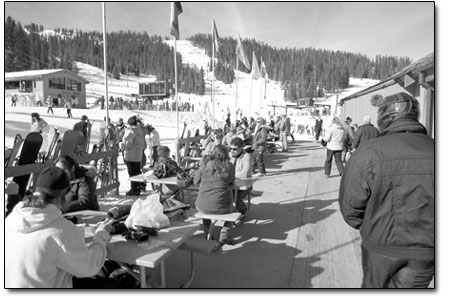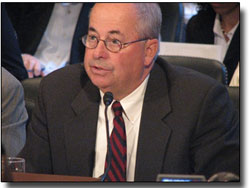| ||||
Coming to terms with climate change
by Allen Best Earlier this summer, ski industry representative Michael Berry testified before a U.S. Senate committee about global warming. His message was one he would not – could not – have given several years ago. “We said it’s time for action,” said Berry, who is president of the National Ski Areas Association, “and it’s time for the U.S. government, instead of dragging its feet at every opportunity, to take a leadership role in this worldwide.” Make no mistake: the ski industry is changing. Four years ago, the industry’s response was a cautious public relations campaign called “Keep Winter Cool.” Some ski areas more privately remained dubious, and others reserved comment. Berry’s organization, NSAA, operates on the basis of quasi-consensus. Aspen was among the few major ski areas that talked loudly about global warming. Now, as demonstrated by Berry’s testimony before the Senate, the industry is speaking forcefully to the issue of humanity’s role in the changing climate. “I think the rest of the industry has come forward in a rather dramatic fashion in the last four or five years,” says Berry. “No doubt Aspen was in the vanguard then, but there’s not much difference in the industry now and what is going on at Aspen.” Auden Schendler, the Aspen Skiing Co.’s executive director for community and environmental responsibility, agrees. “There’s been a sea of change in the understanding of climate science and the seriousness of the problem within the ski industry in the last year,” he said. Berry’s testimony before the Senate committee, he adds, was exactly what he would have given. “It’s great to see this.” California’s experience The hearing was before the Senate Environment and Public Works Committee. The chairwoman, Sen. Barbara Boxer, D-Calif., noted in her statement that the length of the snow season has decreased on average by 16 days from 1951 to 1996 in California and Nevada, according to a National Assessment report issued earlier this year. California’s ski industry got off the climate-change fence five years ago, siding with legislators who wanted to mandate improved automobile efficiency. “Our industry has graphic evidence that climate change is happening,” said Bob Roberts, executive director of the California Ski Industry Association. “We pretty much subscribe (to global warming theory) across the board.” The exception is an unidentified ski area representative who argues that climate change has been hyped by media who have not paid sufficient evidence to contrary science. But that position is in the distinct minority in California, says Roberts. He views the issue as it might be viewed in a court of law, namely: “Where is the preponderance of evidence?” Colorado meeting Colorado ski area managers at their annual meeting this year talked about global warming – a first. With higher elevations, Colorado ski areas may actually benefit from global warming in the short run. In this scenario, people heading to Whistler, which has a top elevation of 7,160 feet, may instead go to Breckenridge, which has a base elevation of 9,600 feet.
Still, any gains will only be short term. A study done as part of the Aspen municipal government’s Canary Initiative roughly calculated that Aspen’s climate will become like the existing climate of Amarillo, Texas. Although Amarillo’s climate is similar to that of Salt Lake City (although Salt Lake never gets mentioned), the comparison is usually just to “Texas,” eliciting images of sweltering Dallas or Houston. But if Aspen and other Colorado resorts aren’t going to become like Dallas, they’re still in a pickle, said Robert Henson, a meteorologist for the National Center for Atmospheric Research. Speaking at the Colorado Ski Country meeting, he noted studies that suggest global warming may produce more snow in the northern Rockies. However, droughts could become more prolonged, particularly in the Southwest. But without ambiguity, the forecasts call for warmer and shorter winters. For every one-degree (Fahrenheit) increase in temperature, he said, the snowline is expected to rise 300 feet in elevation. Some forecasts see temperatures increasing 10 degrees this century, given continued increase in greenhouse gases. As to the cause of this changing climate, Henson said there is little doubt: Human-caused greenhouse gases, particularly the carbon dioxide is the culprit. Resort communities have a large carbon footprint. Aspen’s study found the per-capita emissions of its residents, workers and guests are double those in the rest of the United States. The most salient emissions come from jet travel. Henson said he believes Colorado ski areas are “just beginning to grapple with the future of skiing itself, and how climate will affect them.” Act – but how? What to do? The national ski industry hasn’t taken a formal position – only that action is necessary. NSAA’s Berry says a large group operating within the framework of consensus moves more slowly than individual ski areas can. The Aspen Skiing Co.’s Schendler, with support of the owners, the Crown family of Chicago, can jump on opportunities more rapidly, he said. For example, Aspen was talking sooner about carbon neutrality. But it’s now coming to the ski industry more generally. “We are talking to the U.S. Ski Association about working with them to create carbon-neutral events,” says Berry. In fact, the Colorado ski meeting was set up as a carbon-neutral event. Jen Schenk, environmental manager at Copper Mountain, the host of the meeting, told the Summit Daily News that Ski Country USA purchased renewable energy credits to offset the carbon travel created by the travel and lodging of meeting participants. Whether it’s truly possible for resorts to buy their way out of a carbon footprint is somewhat controversial, as it has been in the larger public – a controversy readily acknowledged by Berry. Since he arrived at Aspen in 1999, Schendler has been doing things like pushing the conversion of light bulbs to more efficient compact-fluorescents, and lobbying for elevated energy efficiency in new real estate being developed at Snowmass, one of Aspen’s four ski areas. But Schendler says beyond action, the ski industry must speak loudly. “The next step,” he says, “is to use the whole industry as a lobbying force to drive large-scale, legislative change. This isn’t about making your resort more energy efficient. It’s about using the whole industry as a club to beat our legislators into action.” Some thinkers, such as Amory Lovins, a physicist and the co-founder of the Snowmass-based Rocky Mountain Institute, believe existing lifestyles can largely be maintained by technical innovations that makes better use of energy. A poll of 50 economists last winter by The Wall Street Journal found that nearly all favored a carbon-emissions tax as a way to stimulate innovation. Several European countries have already adopted such a tax. Others, including James Howard Kunstler, author of The Long Emergency, foresee dramatically different lifestyles. High-rise buildings, suburban and exurban living arrangements and easy mobility will be impossible as the result of reduced oil supplies and growing recognition of climate change, he says. Future not bleak Berry says NSAA has taken no position on precisely what must be done, but he favors the vision of Lovins, that more can be done with less. But crucial to this continued lifestyle, he says, is action now, to prevent the continued rapid buildup of greenhouse gasses. “It’s time to act now, to embrace the best and brightest ideas, as opposed to being cynical about them,” he says. California’s Roberts said he is sure that the future is not bleak. California, with its mandated energy efficiency, is now consuming 50 percent fewer hydrocarbons, yet the economy continues to grow. “The train,” he says, “has already left the station here.” •
|
In this week's issue...
- May 15, 2025
- End of the trail
Despite tariff pause, Colorado bike company can’t hang on through supply chain chaos
- May 8, 2025
- Shared pain
Dismal trend highlights need to cut usage in Upper Basin, too
- April 24, 2025
- A tale of two bills
Nuclear gets all the hype, but optimizing infrastructure will have bigger impact



